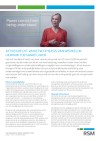The Den Bosch Court of Appeal recently decided on the degree of VAT recovery, whereby institutions such as banks, healthcare institutions and educational establishments may be able to deduct more input VAT. In practice, this could lead to substantial cost relief for companies with both VAT taxed and VAT exempt activities. In this newsletter, we would like to give more insight about the importance of this court judgement and how it may be applicable to your situation.
Facts and circumstances
In the case which came before the Court of Appeal in Den Bosch, the appellant was a banking institution with both VAT taxed and VAT exempt activities. As a result, this institution was unable to deduct all input VAT it incurred. Besides the labour costs, all other costs are considered as general costs. In other words, these costs cannot be attributed to a specific VAT taxable activity. In order to better allocate the costs incurred - and thereby the input VAT - to its business activities, the appellant had compiled three allocation keys based on which the costs can be allocated by the actual use of the expenses.
The aforementioned allocation keys were compiled through the hours/ time registration of the employees, actual product sales and a pro rata basis. Subsequently, these allocation keys were applied per product/activity, after the appellant has performed a profit and loss analysis on various products/ activities, based on which the profitability has been determined. Based on this information, the bank was able to allocate the expenses per product (more) precisely.
In the present case, it was disputed whether the actual usage method adopted by the appellant gave a more accurate insight on the (actual) use of expenses than the standard pro rata method based on the turnover ratio.
JudgementDen Bosch Court of Appeal
The Court disagrees with the Dutch tax authorities that the appellant failed to demonstrate that the applied method reflects the actual usage of costs more accurately. Therefore, the Court has ruled in favour of the appellant.
In doing so, the Court has indicated that the method of the appellant contains sufficient data which can be determined objectively and accurately in order to state that this method reflects the (actual) use of the general costs more accurately than the pro rata method based on the turnover ratio. Furthermore, the Court points out the fact that the allocation keys are (partly) based on estimates and assumptions (lump sum) and that this does not affect its judgement that the used method in question is more precise.
Implications for businesses with mixed activities
The implications of the Court’s decision in practice are positive. To date, the case law in relation to the pro rata - and related to this, the degree of input VAT deduction - has been very strict. In other EU member states, alternatives to the turnover pro rata, such as the ‘actual use method’ or sector approach, have already been applied more widely than in the Netherlands.
Despite the fact that this judgement can still be appealed at the Supreme Court, it can be concluded that based on this ruling, care institutions, banks and educational establishments have been given the opportunity to determine the degree of VAT deductibility by applying the ‘actual use method’. The Court has left flexibility for estimates and assumptions (lump sums), which makes this method more viable for a larger group of entrepreneurs. Therefore, it is highly recommended that entrepreneurs with both VAT taxable and VAT exempt activities investigate whether a method based on actual use provides better insight into the (actual) use of the costs than the currently applied pro rata method based on turnover. This may result in an increased right to recover VAT.
More Information?
Should you have any questions after reading this newsletter or should you need additional details on the consequences of this judgement for your personal situation, please contact your trusted RSM advisor.
Download 'Increased possibilities for VAT recovery based on actual usage' in pdf.

